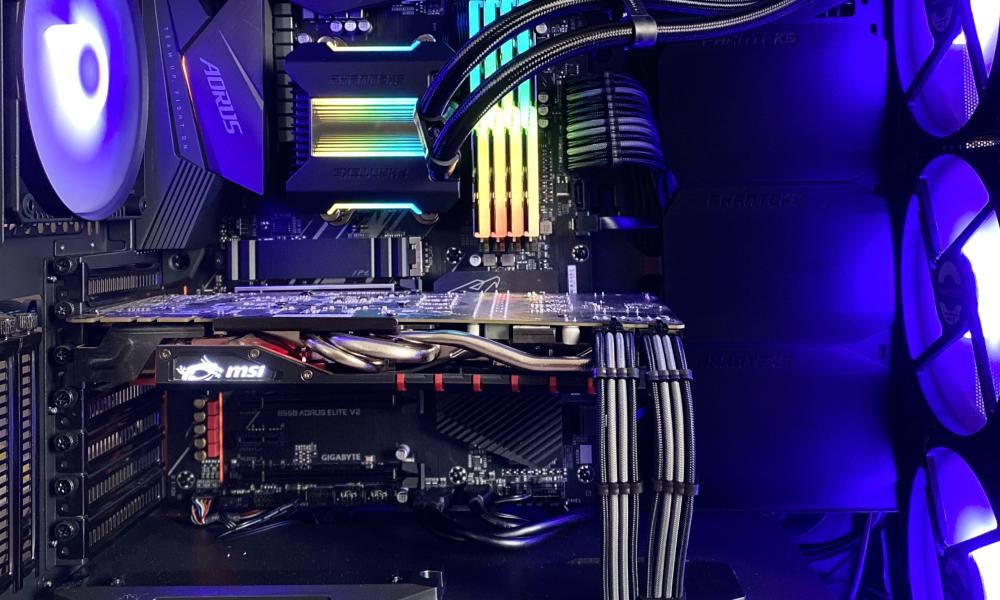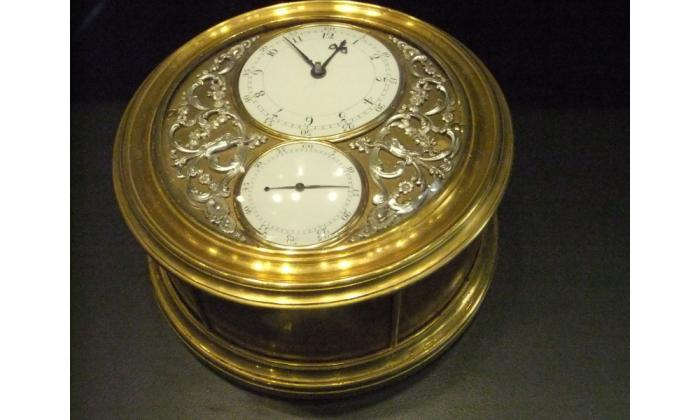Sysadmin hardware: Considerations for planning a PC build

photo by Tyler Carrigan
Disclaimer: In 2021, building and buying computers has seen an enormous uptick. Combine the demand for components with the manufacturing and shipping delays caused by current events, and you have a very tough market to jump into. The newest graphics cards and CPUs can be difficult to find markup. Despite this, the information below will be helpful when planning your next build.
I recently built my first desktop computer system, and wow, let me tell you, I had a great time. I did a ton of research and gained incredible experience during the process, and I wanted to share those lessons learned with you all. I built the computer for high-resolution gaming. However, there are tons of reasons to assemble a new computer in 2021. Whether you are making a home media server, using your system for work, or whatever the case may be, these considerations will apply across the board.
Sometimes, the number of decisions you need to make when building a machine can seem overwhelming. It helps to pick your components in a certain order to avoid incompatibilities. So let's jump into the "order of operations" around a successful build.
1. Case
First, you need to decide on the housing for your system. You need to take into account desk space and your intentions for the build. If you have a tiny desk and want the system on your desk versus on the floor (recommended for cooling), or just want an easily portable build, you may want to consider a small form factor, such as mini ITX, mini ATX, or micro ATX. If you have a large amount of space, you can build a full ATX or EATX tower. For my build, I went with a mid-tower ATX build because it is small enough not to annoy my wife when she sees it and because it was large enough to accommodate a great cooling setup. You'll want to research your case to ensure that it has support for the fans or radiators you want to use. Once you have picked out a case, we start looking at the hardware that goes inside.
2. Processor
At the heart of every system, whether it's a desktop, laptop, game console, or even cell phone, is a central processing unit (CPU). When it comes to considering a CPU for your custom build, there are really only two choices for consumers in most circumstances: Intel or AMD. (Yes, I know Apple is now making their new ARM-based M1 processors but building a custom Mac piece by piece isn't really possible.) Now, I won't get into which of these I think is best. I will just give you some considerations for purchasing a new CPU. When it comes to performance for desktop applications, I still prefer Intel processors for multicore/multi-threaded workloads. AMD processors, on the other hand (the 5000 series), may be a better fit for single-core performance. My CPU of choice was the new AMD Ryzen 5 5600x. I chose this based on the price, which was sub-$300, and its single-core performance for gaming. If I were to build a workstation for productivity, I would have likely chosen an Intel core i7 or i9. My old system has a third-generation i7 from 2012, and it is just now (eight years later) showing its age.
Either way, pick the CPU that meets your specific needs and note the socket of that CPU; you'll need it for the next step. If you're interested in virtualization, for example, be sure to understand the specific requirements of any virtualization software you want to use; sometimes, specific processor extensions are required.
3. Motherboard
Now that we have chosen a CPU, we need something to plug it into. The first thing to look at when selecting a motherboard is this: Is the socket of the motherboard compatible with the CPU you chose? Referencing my build, the AMD Ryzen 5000 series CPUs are only compatible with the AM4 socket. On the flip side of this, Intel's latest CPUs are compatible with the LGA 1200 socket. To avoid compatibility issues, I highly suggest using a tool like PC Part Picker to allow you to pick out your system piece by piece without any compatibility issues. Once you know that the motherboard you selected is compatible with your CPU, you'll want to pay attention to things like PCIe connections, NVMe, or M.2 storage slots, and compatibility with system memory (and how much and in what configurations it is supported). This is an area where it is incredibly easy to overspend, so I recommend finding a board with the features you want and avoid getting caught up in hyper. I chose the AORUS Elite v2 because it supported my processor and the PCIe gen 4 support (this will come into play later in the storage section). It also had two M.2 slots, which was a major plus for upgrading storage in the future.
Memory vs storage
NOTE: Let's consider the difference between memory and storage here. These terms are easily and often confused by consumers, and it's easy to understand why. However, just so everything is clear, memory refers to your Random Access Memory (RAM), and storage refers to the number of GB that you have to store pictures, games, movies, files, etc.
[ You might also like: Troubleshooting hardware problems in Linux ]
4. Memory
As stated above, the term memory refers to your RAM or system memory. It is how your CPU will store and access information during routine computing tasks. When it comes to picking RAM, there are a few things to know. This selection is heavily dependent on your use case for the build. If you are building a workstation that will be doing a ton of multitasking, crunching numbers, or 3D rendering, I highly recommend that you buy as much high-speed RAM as your budget allows. If you are gaming, you really don't need more than 16GB of DDR4 (the current generation of RAM). You can always add more later if you need it, assuming that your motherboard has the DIMMS to support it.
NOTE: Intel CPUs don't show huge gains in performance when you exceed RAM speeds of 3200MHz. However, AMD CPUs, specifically the 5000 series, show large gains with faster memory kits. I went with 32GB of 3600MHz RAM from G.SKill due to performance. It was a little more than I had planned to spend, so if your budget is tight, you can totally get away with 16GB for most applications.
5. Storage
Next, let's talk about storage. This part is pretty easy, as you only have two big choices here: Standard spinning disk drives (HDD) or solid-state (SSD). Remember, you can always add more later, so try to be realistic about your capacity needs. SSDs used to be very expensive in large capacity drives, however, prices have dropped dramatically over the last five years or so. Also, there have been introductions in form factors that make a convincing case for themselves. For example, in the end, you have to put it all together and plug everything in. Traditionally, every hard drive needed a data connection to the motherboard and a power connection from the power supply. With the introduction of NVMe and M.2 memory standards, you can literally install 2TB drives with zero cables or wires. That's huge for cable management and overall ease of installation. If you do need a huge amount of storage, hard disk drives are still the most cost-effective way to do it. This can be a great way to build a media server. If you are doing any type of editing or media work, I recommend you get the fastest storage medium possible. Maybe a large capacity M.2 drive (PCIe gen 4 can read/write north of 5000 MBs per second—that's crazy). For my build, I went with a Sabrent 1TB Rocket Q4. This is a budget entry into the PCIe 4.0 M.2 space, and wow, is it fast. My operating system is installed here, and it boots in under 10 seconds. Fast storage really can change how your interact with your PC in pretty noticeable ways.
6. Graphics
Graphics can be a super fun part of the build. If you're a gamer, this may be the single most expensive piece you will buy. However, if your PC will just be for more standard tasks, you can get some pretty basic components, and it will be fine. If you are building a gaming PC, or planning to use your computer for graphics-intensive tasks like 3D rendering, this is where most of your performance will come from, so I advise you to buy the best card that your budget allows. You have two main options for gaming cards: NVIDIA or AMD. For standard tasks, they're well-matched, so do your research about what will work best with any specific needs you have.
Graphics cards are hard to purchase right now, with tales of people sleeping in parking lots for a chance to buy the latest tech, and cards from two or three generations ago are sold out online. I actually haven't been able to find the card that I selected for my build, so I am still using my old graphics card in my current system until the demand levels out a bit.
7. Cooling
One of the last but most important considerations for your build is how you will keep it all cool. Physics isn't for everyone, but electricity generates heat, and heat destroys components, so keeping your CPU and GPU cool is a top priority. You can use fans to do most of the heavy lifting in mid towers or full towers but will want to use an All in One liquid cooler (AIO) for smaller cases or high-performance parts. My case has three 140mm fans sucking air into the front and exhausting it out of a rear 140mm fan. My CPU is being cooled by a 360mm AIO that pumps cold water across a heat exchanger on the CPU and then pushes that heated water to a radiator where three additional fans push the heat up and out of the system. Most modern GPUs have large heat sinks and fans to keep the heat away from the most vital components, but these can also be water cooled if necessary.
8. Power supply
Power supplies are a pretty easy component to pick out, and so long as you have enough wattage and the thing fits in your system, it will probably work. One thing to consider is modularity, which just helps keep your system a bit less cluttered. Again, just check with your graphics card and CPU to ensure that you meet the minimum requirements for those components as they are the most power-hungry. You will see a rating system for certain supplies that are 80+ certified. These are efficiency ratings, and can help reduce the cost and impact of operating your machine over time. 80+ gold PSUs are a good place to start. I chose an 80+ gold certified 850watt PSU from Phanteks. It was modular and came with a long warranty.
9. Operating system
Now that all of the hardware has been considered, you need to figure out what software you will run on your new system. Of course, multi-booting is an option. But be sure to consider the cost of any operating systems or other software you wish to install in your overall budget.
10. Build prep and roundup
Congratulations on planning out a successful build! There is so much to consider when assembling a system, and there are a ton of good resources out there. Do your homework, buy from reputable retailers, and when it comes time to put all these things together, remember these few things:
- Read the manuals.
- Be sure you are electrostatic discharge-safe (use a grounding strap or just touch something metal before handling your components).
- Get a nice magnetic screwdriver for the case components (you're welcome).
- It can be easier sometimes to assemble all of the motherboard components before you install the motherboard to the case.
- Read the manuals (seriously).
- Buy a bag of small black zip ties and a good pair of small side cutters.
For those of you curious about my build total and the time it took to put together here are those numbers:
- Case - Phanteks p500a - $139.99
- CPU - AMD Ryzen 5600x - $299.99
- Motherboard - Aorus B550 Elite V2 - $159.99
- Memory - 32 GB (4x8) GSkill Trident Z Neo 3600 CL18 - $234.99
- Storage - Sabrent 1TB Rocket Q4 - $149.99
- Samsung EVO 860/840 1TB/125GB (old drives from my other system)
- GPU - NVIDIA RTX 3080 - TBD (out of stock)
- Cooling - 4 x Phanteks sk140 case fans (three included, one purchased at $17.99)
- Phanteks Glacier One 360 AIO - $169.99
- Power supply - Phanteks Revolt Pro 850 - $129.00
- Operating system - Windows 10 Home digital, for gaming - $139.99
- TOTAL - $1442.91 (no graphics card)
I worked on this build for over a week as parts trickled in. However, if I had all the components at one time, I would estimate this build at around 3-4 hours. Keep in mind this was my first build from the ground up, so your mileage may vary.
Have you recently built a new computer for a specific task? We'd love to hear about what considerations you made for your specific situation. Consider submitting an article proposal to enable-sysadmin@redhat.com.
[ Want to test your sysadmin skills? Take a skills assessment today. ]




Tyler Carrigan
Tyler is the Sr. Community Manager at Enable Sysadmin, a submarine veteran, and an all-round tech enthusiast! He was first introduced to Red Hat in 2012 by way of a Red Hat Enterprise Linux-based combat system inside the USS Georgia Missile Control Center. More about me


